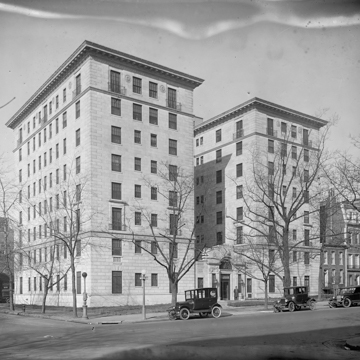One of the earliest apartment houses along fashionable 16th Street south of Scott Circle, the Jefferson, constructed in 1922, soon was followed by other apartment houses for the affluent and by private clubs. After World War II, as commercial uses increased, apartment living in the area became less desirable. Now operated as a hotel, the Jefferson appeals to visitors who prefer a more intimate environment than that found in the massmarket hotels.
The Jefferson's U-shaped plan offers natural light and ventilation to the interior of the building. The eight-story facade of carved limestone is divided into a base, shaft, and entablature; it is embellished by stone quoins at the building's edge, heavy window surrounds, and wrought-iron balconies. A welcoming one-story Renaissance entrance and corridor fill in the court of the U and leads to an elaborate lobby enlivened by niches, pilasters, and fine plasterwork.














